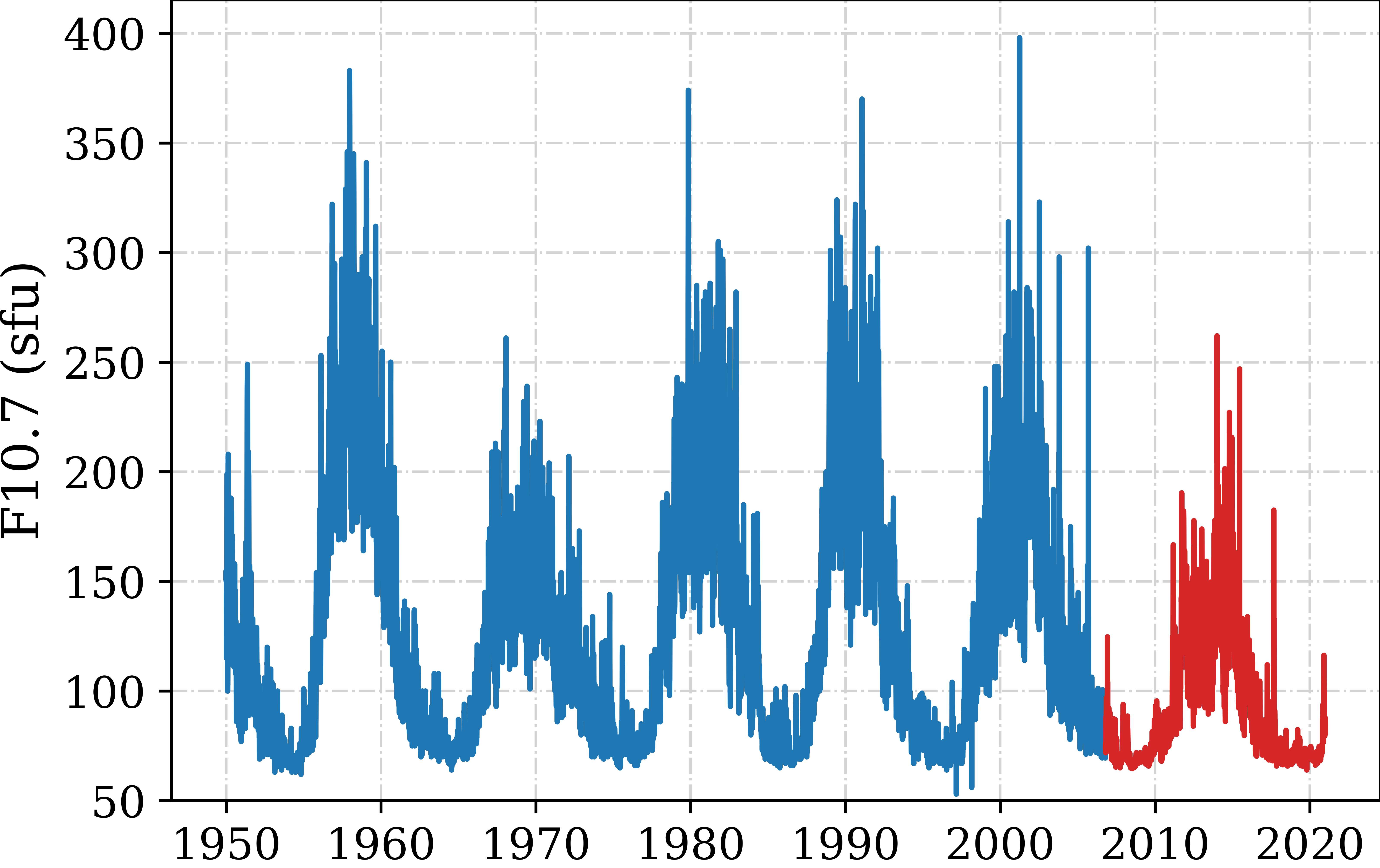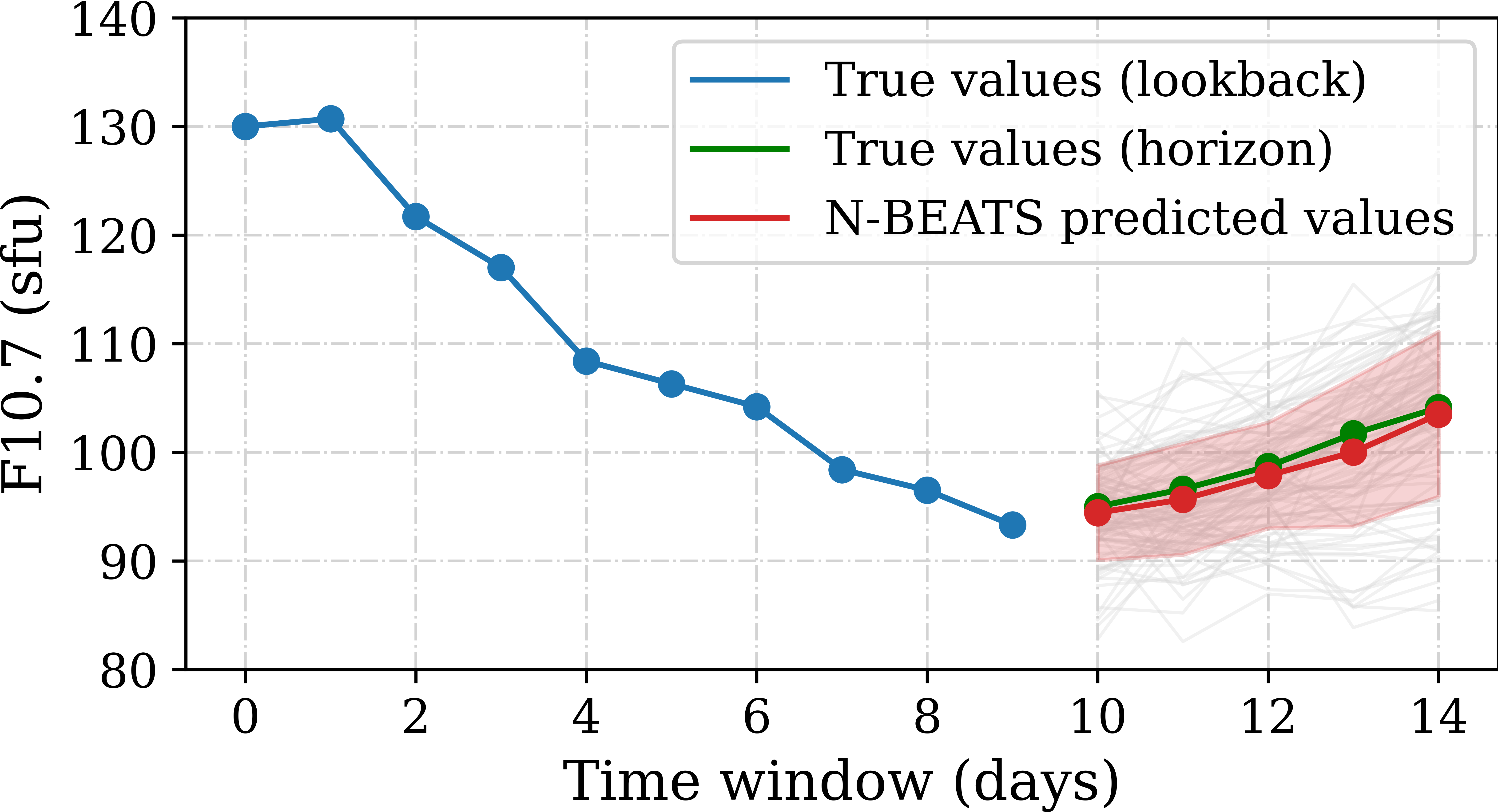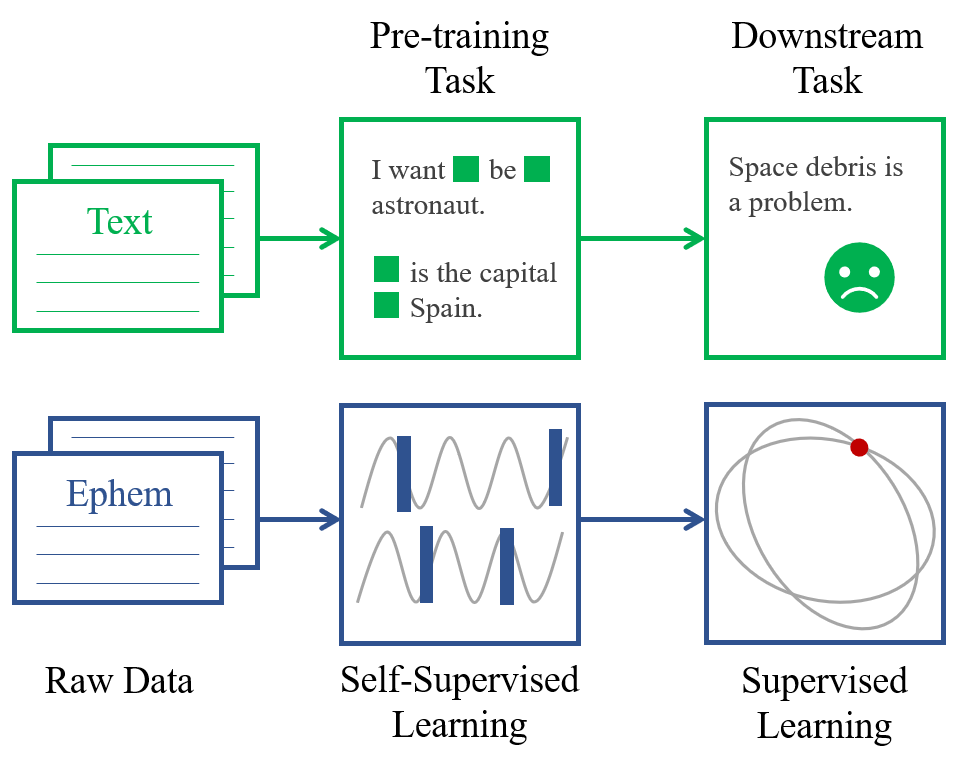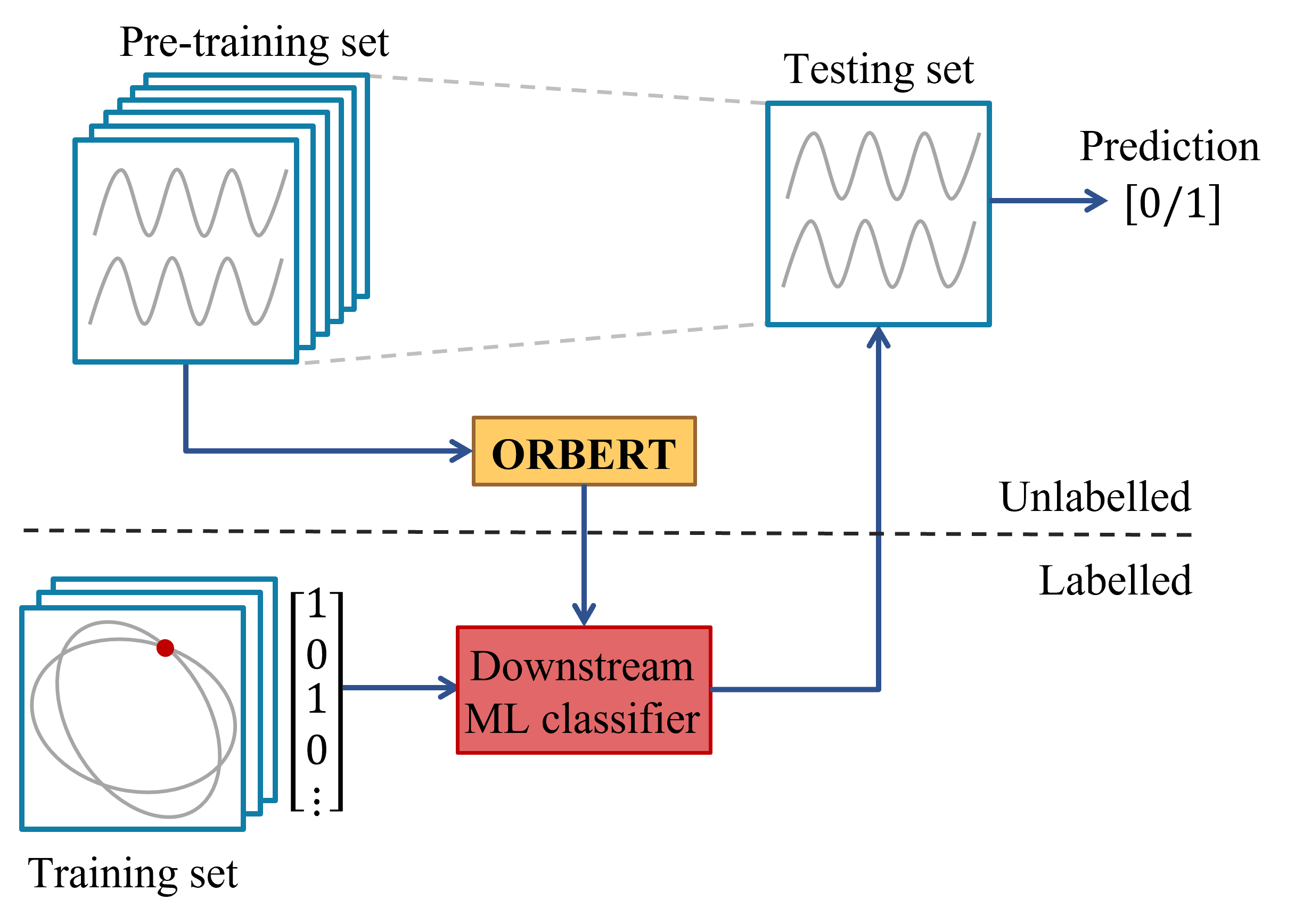Deep Learning for Space Traffic Management
Contents
- Introduction
- Space Weather Proxy Forecasting for Orbital Prediction
- Conjunction Assessment
- References
Introduction
In this section, we introduce the application of Artificial Intelligence techniques, specifically those of machine and deep learning to the domain of space traffic management and space situational awareness as a part of the research output of ESR 12.
Space Weather Proxy Forecasting for Orbital Prediction
Solar Flux Forecasting
The effect of atmospheric drag on spacecraft dynamics is considered one of the predominant sources of uncertainty in Low Earth Orbit. These effects are characterised in part by the atmospheric density, a quantity highly correlated to space weather. Current atmosphere models typically account for this through proxy indices such as the F10.7, but with variations in solar radio flux forecasts leading to significant orbit differences over just a few days, prediction of these quantities is a limiting factor in the accurate estimation of future drag conditions, and consequently orbital prediction. This has fundamental implications both in the short term, in the day-to-day management of operational spacecraft, and in the mid-to-long term, in determining satellite orbital lifetime.

In these works [1, 2], we employed a novel deep residual architecture for univariate time series forecasting, N-BEATS, for the prediction of the F10.7 solar proxy on the days-ahead timescales relevant to space operations. This untailored, pure deep learning approach has recently achieved state-of-the-art performance in time series forecasting competitions, outperforming well-established statistical, as well as statistical hybrid models, across a range of domains. Our approach was found to be effective in single point forecasting up to 27-days ahead, and was additionally extended to produce forecast uncertainty estimates using deep ensembles. These forecasts were compared to a persistence baseline and two operationally available forecasts: one statistical (provided by BGS, ESA), and one multi-flux neural network (by CLS, CNES). It was found that the N-BEATS model systematically outperformed the baseline and statistical approaches, and achieved an improved or similar performance to the multi-flux neural network approach despite only learning from a single variable.

Conjunction Assessment
All vs. All Conjunction Screening
In recent months, there have been several high-profile near-miss conjunction events, most notably of which, and of greatest concern, were those between two non-manoeuvrable space debris objects. To detect such a potentially catastrophic event, it is essential to search for conjunctions between all possible sets of catalogued objects, both active and debris. However, this scenario, so-called all vs. all, is extremely computationally expensive, with hundreds of millions of possible collision pairs to continually screen for conjunctions over the screening period. These computational challenges will be exacerbated by the future space environment, with increasing space traffic and improved observational capabilities resulting in a substantial increase in the number of catalogued objects and, consequently, the number of possible conjunction pairs.
One potential approach to handling the computational burden required for current, and future, conjunction screening of the full space object population, is the application of Artificial Intelligence (AI). In [3], we present a proof of concept for the application of AI to the problem of efficient, catalogue-wide conjunction screening. Framed as a machine learning classification task, an ensemble of tabular models were trained and deployed on a realistic all vs. all dataset, generated using the CNES BAS3E space surveillance simulation framework, and consisting of 170 million object pairs over a 7-day screening period. The approach was found to outperform classical filters such as the apogee-perigee filter and the Minimum Orbital Intersection Distance (MOID) in terms of screening capability, with the number of missed detections of the approach controlled by the operator. It was also found to be computationally efficient, thus demonstrating the capability of AI algorithms to cope and aid with the scales required for current and future operational all vs. all scenarios. In [4], we extended this analysis to consider whether the performance of the model could be improved by considering a time series approach, based on full orbit ephemerides as inputs, and using more powerful deep learning architectures such as those based on Convolutions or Attention. We found that although these approaches did offer improved performance, and better captured the effects of orbital perturbation effects, they came with increased computational costs, resulting in a trade-off between between performance and computational efficiency.
ORBERT: A Self-Supervised Orbit Model
Inspired by the breakthrough success of BERT-like self-supervised language models in the field of natural language processing, in [5] we proposed a new methodology for exploiting large quantities of readily available orbit data to improve the performance of ML-based STM tasks such as all vs. all conjunction screening.
For this, we drew the following parallel between space traffic management (STM) and natural language processing (NLP) tasks: just as the former relies on our ability to accurately model orbits, different NLP tasks, such as next word prediction or sentiment analysis, rely on an underlying common understanding of how to model language. The latest breakthroughs in this latter field can be attributed to the use of self-supervised learning (SSL), whereby high-performance underlying language models such as Google’s BERT can be pre-trained on extensive datasets by predicting masked words from text, before being fine-tuned to the objectives and data of specific downstream tasks, thus improving both performance and efficiency. Applying this same concept, we introduce our self-supervised pre-trained orbit model, ORBERT, which is trained by masking and reconstructing sections of orbit ephemerides in order to learn meaningful orbit representations which can be used to aid in a variety of downstream orbit-related tasks.

Although we stress that this novel technique could be applied to a wide variety of different tasks in the STM domain, we have chosen to apply it to the downstream task of all vs. all conjunction screening. To make full use of this technique and leverage readily available orbit data, we phrased this as a time series classification task (as discussed above), and the concept is illustrated below. This pipeline enables us to make use of large quantities of “unlabelled” orbit data by pre-training a model that already understands how orbits work, and the effects of different perturbation regimes, which can then be used as a foundation for the final, target model, which is trained in a supervised way using “labelled” data for the specific downstream task (high risk/low risk conjunction classes).

References
[1]: Stevenson, E., Rodriguez-Fernandez, V., Minisci, E., Camacho, D. (2020). A Deep Learning Approach to Space Weather Proxy Forecasting for Orbital Prediction. In Proceedings of the 71st International Astronautical Congress (IAC), The CyberSpace Edition, 12-14 October 2020.
[2]: Stevenson, E., Rodriguez-Fernandez, V., Minisci, E., Camacho, D. (2021). A Deep Learning Approach to Solar Radio Flux Forecasting. Acta Astronautica. ISSN 0094-5765, https://doi.org/10.1016/j.actaastro.2021.08.004.
[3]: Stevenson, E., Rodriguez-Fernandez, V., Urrutxua, H., Morand, V., Camacho, D. (2021). Artificial Intelligence for All vs. All Conjunction Screening. In Proceedings of the 8th European Conference on Space Debris, 20-23 April 2021.
[4]: Stevenson, E., Rodriguez-Fernandez, V., Urrutxua, H., Morand, V., Camacho, D. (2021). An Assessment of Machine Learning Techniques for Orbital Conjunction Screening. In Proceedings of the Stardust-R Global Virtual Workshop II on “Space Traffic Management and Resilient Space Environment”, 13-17 September 2021.
[5]: Stevenson, E., Rodriguez-Fernandez, V., Urrutxua, H., Morand, V., Camacho, D. (2021). Self-supervised Machine Learning Based Approach to Orbit Modelling Applied to Space Traffic Management. In Proceedings of the 11th International Association for the Advancement of Space Safety (IAASS) Conference “Managing Risk in Space”, 19-21 October 2021.